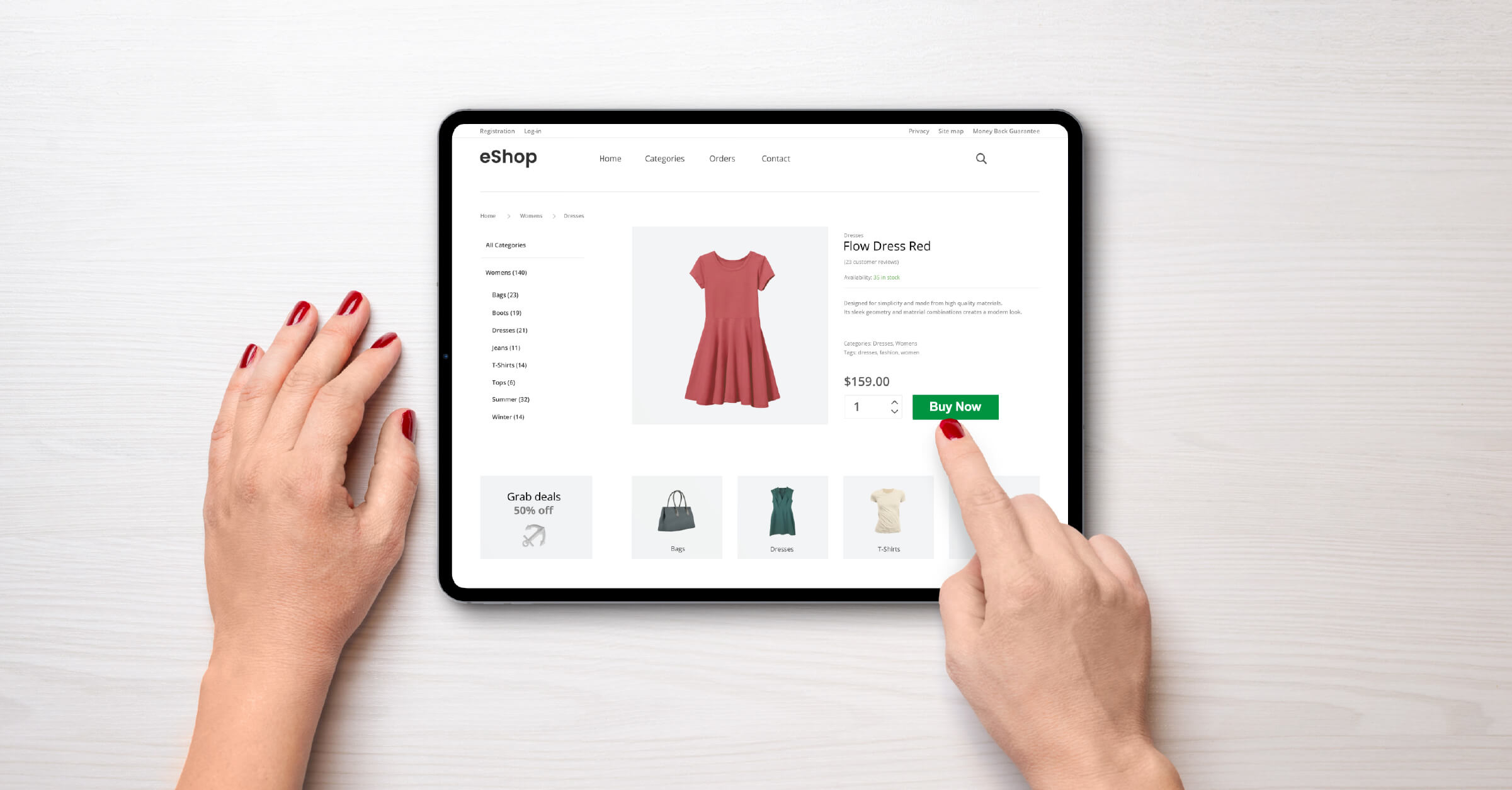January 11, 2023
12 Ways to Improve E-commerce Conversion Rates

If you’re running an online store, you know that increasing your e-commerce conversion rate is essential to your long-term success. But what is a good e-commerce conversion rate? And once you know how to recognize it, how do you improve it?
This article will look at e-commerce conversion rates. Including what’s considered a good rate, and the steps you can take to improve yours. We’ll also dive into some tried and tested strategies for boosting personalization to drive e-commerce conversion.
What is an e-commerce conversion rate?
An e-commerce conversion rate is the percentage of visitors who take a specific action on your site, such as making a purchase or signing up for a newsletter. It is calculated by the number of people who completed an action (purchased an item, signed up for an account, etc.) divided by the total number of visitors to your website in a given period.
For example, if you had 100 website visitors and 10 of them purchased something, your e-commerce conversion rate would be 10%.
What is a good e-commerce conversion rate?
The average e-commerce conversion rate varies widely depending on the industry and product. Generally speaking, an e-commerce conversion rate of 2%-3% is considered good, and anything above 3% is considered excellent.
How to improve your e-commerce conversion rate
Improving your e-commerce conversion rate requires optimizing your website and developing effective personalization strategies. Here are some tips to help you get started.
1. Personalize language across every touchpoint
The language you use on your website and in marketing materials plays a huge role in determining whether someone will complete a conversion.
Personalization is the key to improving e-commerce conversion rates. By creating a consistent message and tailoring it based on the customer’s known preferences, businesses can create an emotional connection that encourages customers to act.
For example, the omnichannel arts and crafts retail chain Michaels used the Persado platform to determine the most effective language for each customer interaction based on its audience, channels, and campaigns. Using a custom language model that is true to the Michaels brand voice, Persado generated language and ran experiments to understand customer engagement and identify the best messaging.
This attention to personalization has enabled Michaels to increase its e-commerce conversion rate by 41% on average for SMS campaigns, and 25% for email. These results indicate that when customers receive personalized messages that resonate with them, they are more likely to convert.
You can implement language personalization at every stage of the customer lifecycle:
Awareness
Generate dynamic messaging across various platforms that will capture customer attention. For example, if customers want to save money, create ads highlighting competitive pricing or special offers. If a customer is looking for convenience, promote your fast delivery options. One home goods store saw a 66% increase in in-store sales when it included language personalization in ad campaigns.
Consideration
Personalized product images and detailed descriptions help boost conversion rates. Include customer reviews to provide a clearer picture of how the product has worked for others. Additionally, create content outlining each solution’s pros and cons to assist prospects in comparing options and making an educated decision.
Cart abandonment
It’s not just about getting customers to add items to their cart. It’s also about ensuring they complete the purchase. To reduce cart abandonment and improve e-commerce conversion rates, use AI platforms like Persado Motivation AI to craft personalized messages for each customer based on their behavior, past purchases, and other factors.
Service and support
Personalization is also the key to great customer service in e-commerce. Customers don’t want to feel like just another number; they want to be seen, heard, and valued as individuals. With AI personalization tools, you can tailor each interaction to the individual — sending personalized product recommendations based on their interests and purchasing habits.
Engagement
You can also use AI tools to drive customer engagement and loyalty. By delivering the right content at the right time, you can create a more memorable customer experience that keeps customers coming back. Vodafone saw an 11% lift in sales when it implemented AI personalization technology across its channels.
Loyalty
Personalizing your upsells, cross-sells, rewards, branded credit cards, and partner programs with motivating messages can improve customer loyalty.
2. Incentivize return to cart
Cart abandonment is a common issue for e-commerce stores and lowers e-commerce conversion rates. Data from the Baymard Institute shows average cart abandonment rates are anywhere from 60-80%.
Here are some of the reasons customers fail to complete purchases:
Source: Baymard Institute
Personalized cart abandonment emails can help drive conversions. Why? Because helpful and relevant product recommendations or discounts on items shoppers left in their shopping cart can provide the boost they need to return to buy them. Data from Klaviyo shows that marketers recoup $60 million in sales over a three-month window using abandoned cart emails.
Tools like the Persado Motivation AI Platform help you craft the right message for each customer. This increases the chances of converting abandoned carts into paying customers — ultimately improving your e-commerce conversion rates.
3. Offer enhanced customer support
If your e-commerce store has slow or inadequate customer service, this will likely impact your conversion rate.
To ensure you’re offering the best customer support experience possible, think about hiring additional staff, implementing chatbots, or offering 24/7 customer service.
Live chat support is becoming increasingly popular as it allows customers to ask questions and get answers in real time. It can make your website more user-friendly at the same time that it gathers important data on what is working, and not working, in your e-commerce store. Live chat software can use online tools like Google Translate to accommodate customers who speak different languages.
Data from Invesp reveals that 63% of consumers are more likely to return to a website that offers live chat, and 77% would make a purchase only if they could access live chat support.
4. Write clear product descriptions
When looking to increase e-commerce conversion rates, product descriptions are integral. Customers want to know what they’re buying, and the more information you provide in an easy-to-read format, the better.
You might be surprised that 10% of the biggest e-commerce websites don’t have consistently detailed product descriptions. Poorly written product descriptions can make customers feel as though they don’t know enough about the product, which can lead them to abandon their purchase.
Good product descriptions should be detailed yet concise and provide factual information and a bit of personality to engage customers. Avoid excessive jargon, and make sure to include the product name and any unique features that might help it stand out from similar items.
Source: Michaels
5. Simplify the checkout process
Data shows that 17% of shopping cart abandonments are caused by long and complicated checkout process. Brands can simplify the check-out process by adding one-click purchasing, payment options, and reducing the number of fields to fill out.
The Baymard Institute recommends aiming for as few as 12-14 form elements (7-8 if only counting the form fields) for an ideal checkout flow. Yet, data shows most e-commerce sites have almost 24 form elements.
Source: Michaels
6. Use high-quality product images
Once a customer lands on your product page, you have just a few seconds to make an impression.
High-quality product images can help create a positive first impression of your brand and product quality, even at a glance.
Including multiple product images from different angles is the best way to ensure that customers get a full view of your products. Multiple views allow customers to accurately visualize the product they’re considering buying, which can help increase e-commerce conversion rates. According to Shopify, 58.03% of customers prefer product images that give them a 360-degree view of the product.
Source: Athleta
7. Personalize visitor pathways
Creating personalized pathways can motivate customers to add one or more items to their cart and complete a purchase. You can do this by grouping related products in collections, such as introducing users to a special “Back To School” collection if they look at items that pertain to that season.
You can also use personalization features, such as recommending related products or offering discounts at checkout for additional items.
Source: The Gap
8. Display social proof
Social proof is the tendency to consider others’ experiences when weighing a decision. You can leverage this concept by showing your customers that others have bought and enjoyed your products.
Consider displaying recent purchases, customer reviews and ratings, celebrity endorsements, social media followings, and logos of well-known customers. This will provide a sense of validation for potential customers that your product or service is worth investing in.
Make it easy for customers to review your products after purchase. Customer reviews can impact e-commerce conversion rates significantly, and having them readily available can help drive more sales.
Source: Marks & Spencer
9. Explain shipping and return policies
Studies have shown that 79% of shoppers are incentivized to shop more when offered free shipping. In addition, large retailers like Amazon have made free shipping and returns an expectation. But, if that’s not something you can offer, clearly explain your shipping and return policies on each product page.
Make sure you are clear about what is covered in the policy (e.g., who pays for return shipping) and any restrictions (e.g., certain products can’t be returned).
A clear shipping and return policy helps your customers make informed decisions about their purchases and improves their experience with your e-commerce store. This can lead to higher customer satisfaction rates, increased customer loyalty, and improved e-commerce conversion rates.
10. Include clear checkout CTAs
Alongside making your checkout process fast and easy, it is important to include clear call-to-actions (CTAs) for checkout and add-to-cart options.
A purchase button should stand out from the rest of the page. For example, if your brand colors are blue and green, try using red, orange, or yellow CTAs.
11. Reduce friction points
One of the biggest enemies of e-commerce conversion is friction. Friction is any aspect of the user experience that causes confusion or requires excessive effort. Friction points include hidden shipping costs, unclear checkout processes, and even unusable buttons. Identifying and reducing friction points on your e-commerce website is essential to ensure a smooth user experience and a healthy conversion rate.
12. Continuously test your process
If you want to know where your customers are dropping off or where they are likely to abandon their carts, you need to run A/B tests and understand what works best for your target audience.
Tools like Google Optimize make it easy to run tests without investing in a full-scale website redesign. You can test features like button color, font size, and changes to the entire checkout process.
Ultimately, the goal is to create a smooth and secure checkout experience that compels users to take action. After all, an optimized e-commerce conversion rate is key for any successful online store.
Increase e-commerce conversion rates with Persado
While there are many factors to consider when creating a successful e-commerce strategy, it all comes down to understanding what motivates your customers.
This is where the Persado Motivation AI Platform comes into play. Our platform uses machine learning to create personalized messaging that drives conversions.
The Persado Motivation AI platform helps e-commerce businesses maximize their conversion rate and optimize every digital touchpoint across the purchase process.
Learn more about how Persado has helped leading e-commerce brands in our latest case studies.


